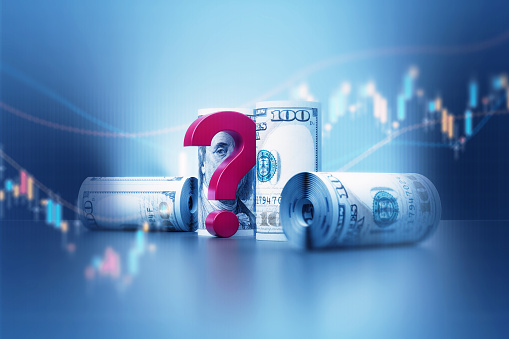Ask The Rational Investor: The Hidden Cost When Investors Pay for Certainty

Investors don't just prefer certainty; they crave it. This preference often works against their long-term interests. Our decision-making becomes particularly risk-averse after experiencing market volatility. While seeking safety is instinctive (an evolutionary survival mechanism), certainty carries a substantial price tag that many fail to recognize.
The past several years have presented numerous challenges for market participants. Following monetary tightening in 2022-2023, regional banking concerns, and persistent recession anxieties, investor fatigue has become widespread. Cash allocations have increased substantially, with U.S. money market funds attracting nearly $6.8 trillion in assets as of early 2025, representing approximately 18% of household financial assets. This allocation shift appears logical on the surface: Federal Reserve policy pushed money market yields above 5%, making cash instruments more attractive than they've been in nearly two decades.
However, this flight to safety reveals a psychological response to perceived risk that frequently undermines investment outcomes. Market history demonstrates this pattern repeatedly. Following the 2008 financial crisis, retail investors withdrew $151 billion from equity funds in 2009 while institutional investors increased cash reserves significantly. Those who remained on the sidelines missed the early stages of a historic bull market where a single dollar invested in the S&P 500 at the March 2009 low would have grown to $8.14 by December 2020—an annualized return of 17.5% including dividends.
The COVID-19 market disruption in 2020 generated similar behavior. Investors withdrew $326 billion from equity funds in March 2020 alone, just before one of the most powerful recoveries in market history began. By moving to cash precisely when markets offered the greatest opportunity, safety-seekers locked in losses and missed substantial gains. Even during the brief bear market of late 2022, those who moved to cash missed the subsequent 2023 recovery that saw the S&P 500 gain over 24%.
The most significant problem with safety-seeking behavior isn't just missing market rebounds. It's the gradual erosion of purchasing power. Even at the Federal Reserve's target inflation rate of 2%, cash holdings lose approximately 18% of their purchasing power every decade. The actual inflation experienced by most Americans, particularly for essential goods and services, has frequently exceeded official measures. Consider this perspective: $10,000 kept in cash since 2000 would have lost approximately 45% of its purchasing power by 2024, while the same amount invested in a diversified equity portfolio would have grown to approximately $50,000 even after accounting for multiple bear markets.
Gold provides another instructive example. As inflation concerns intensified in 2022-2023, gold attracted significant investment flows, reaching all-time highs above $2,600 per ounce in late 2024. Yet gold's inflation-adjusted performance over extended periods tells a different story. Since its previous peak in January 1980, gold has delivered a real annualized return of approximately 0% through October 2024, compared to 7.8% for the S&P 500. Even traditionally "safe" fixed-income investments have demonstrated vulnerability. In 2022, government bonds experienced their worst year in modern history, with the Bloomberg U.S. Aggregate Bond Index falling 13.01%—a stark reminder that even assets perceived as safe harbors can experience significant volatility.
Perhaps the most compelling evidence against excessive safety-seeking comes from examining the impact of missing just a handful of the market's best days. According to J.P. Morgan's analysis, an investor who remained fully invested in the S&P 500 from 2004 through 2024 would have achieved an annualized return of 9.9%. However, missing just the 10 best trading days during this 20-year period would have reduced returns to 5.5%, cutting total portfolio growth by more than half. The critical insight: seven of those ten best days occurred within two weeks of the market's worst days. Investors who retreat to safety during periods of maximum pessimism almost inevitably miss the most powerful recovery days.
Every asset capable of generating meaningful long-term wealth requires embracing some uncertainty. Equity markets deliver superior returns precisely because investors demand compensation for volatility. Risk isn't merely something to be tolerated; it's the fundamental driver of returns. Sophisticated investors understand that uncertainty cannot be eliminated, only managed. They recognize that the greatest risk isn't short-term volatility but the long-term failure to build wealth that outpaces inflation, funds retirement, and achieves financial goals.
Certainty in investing is largely illusionary: a premium investors pay for psychological comfort that frequently undermines long-term outcomes. Markets don't reward comfort-seeking; they reward those willing to endure discomfort when others retreat. The path to investment success requires viewing risk not as price volatility but as the permanent impairment of capital or the failure to meet long-term financial objectives. By this definition, the perceived "safety" of cash or ultra-conservative assets may actually represent the greatest risk of all.
Sources: Investment Company Institute, Bloomberg, Morningstar, BLS.gov, World Gold Council, JP Morgan
About Beese Fulmer Private Wealth Management
Beese Fulmer Private Wealth Management was founded in 1980 and is one of Stark County’s oldest and largest investment management firms. The company serves high-net-worth individuals, families, and non-profits, and has been ranked as one of the largest money managers in Northeast Ohio.
